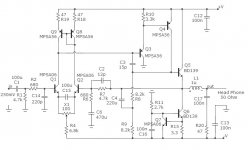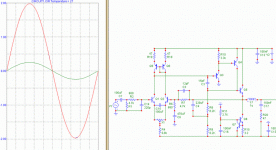Could someone kindly run a simulation on my modified class A headphone amp regarding its performance such as distortion, slew rate, band width, etc.
With my old HP distortion analyser I cannot measure any distortion at 200kHz becuase its residual distortion seems higher than this amp. Can anyone help?
The supply is ±15V. The input is 250 mV and provides 2V output into 50 Ω. and the pot is set to give an output off-set around 40µV.
Kindest regards
Nico
With my old HP distortion analyser I cannot measure any distortion at 200kHz becuase its residual distortion seems higher than this amp. Can anyone help?
The supply is ±15V. The input is 250 mV and provides 2V output into 50 Ω. and the pot is set to give an output off-set around 40µV.
Kindest regards
Nico
Attachments
Netlist said:First impression, more tomorrow. 🙂
/Hugo
Thanks so far Hugo, I appreciate the trouble.
Kind rgards
Nico
Hi,
If you don't mind, I would like to simulate also, just to compare results.
Also, I'm looking for a good , simple headphone amp to do.
If you don't mind, I would like to simulate also, just to compare results.
Also, I'm looking for a good , simple headphone amp to do.
Very nice! Very good performance. I measured distortion at less than 0.0009% at 1KHz and 0.001 at 20KHz.
Stability can be improved by increasing C3 from 15p to 100p. This is demonstrated in the graphic below. Top chart is the Miller cap at 15p, the bottom at 100p. Signal is taken from the base of the EF (Q3).
Stability can be improved by increasing C3 from 15p to 100p. This is demonstrated in the graphic below. Top chart is the Miller cap at 15p, the bottom at 100p. Signal is taken from the base of the EF (Q3).
Attachments
MJL21193 said:Very nice! Very good performance. I measured distortion at less than 0.0009% at 1KHz and 0.001 at 20KHz.
Stability can be improved by increasing C3 from 15p to 100p. This is demonstrated in the graphic below. Top chart is the Miller cap at 15p, the bottom at 100p. Signal is taken from the base of the EF (Q3).
Hi can you show results with C3 = 100p, I think it will cause oscilation at about 5 MHz. Check bandwidth and see if there are spikes high up.
Maybe after a few more improvements, do you think we should do a PCB?
Kind regards
Nico
MJL21193 said:Very nice! Very good performance. I measured distortion at less than 0.0009% at 1KHz and 0.001 at 20KHz.
Stability can be improved by increasing C3 from 15p to 100p. This is demonstrated in the graphic below. Top chart is the Miller cap at 15p, the bottom at 100p. Signal is taken from the base of the EF (Q3).
C3 = 100p is acceptable, no nasties higher up.
Limits the bandwidth and has smooth high side roll-off just above 1 MHz on my spectrum analyser/tracking gen. Still cannot see any distortion on the audio analyser.
Nice improvement, what else have you in mind.
Have you tested to download the freeware from Linear?
http://www.linear.com/designtools/software/switchercad.jsp
Then you can fool around yourself. Quite many here have experience of this software.
http://www.linear.com/designtools/software/switchercad.jsp
Then you can fool around yourself. Quite many here have experience of this software.
peranders said:Have you tested to download the freeware from Linear?
http://www.linear.com/designtools/software/switchercad.jsp
Then you can fool around yourself. Quite many here have experience of this software.
Thanks, will check it out.
I just realized that others can do a far better job than me so I'll watch from a distance. 🙂
/Hugo
/Hugo
Netlist said:I just realized that others can do a far better job than me so I'll watch from a distance. 🙂
/Hugo
I have just downloaded MicroCAP9 demo from http://www.spectrum-soft.com/index.shtm. Now this is not a computer game like these free packages on offer!
Simulated the circuit and my goodness, voltages and currents predicted by the package is identical to the prototype I made. Thanks guys for helping me.
I am so impressed with the simulation package that I have ordered the full version at only $ 4630, it is a steal.
MJL21193 said:Very nice! Very good performance. I measured distortion at less than 0.0009% at 1KHz and 0.001 at 20KHz.
Stability can be improved by increasing C3 from 15p to 100p. This is demonstrated in the graphic below. Top chart is the Miller cap at 15p, the bottom at 100p. Signal is taken from the base of the EF (Q3).
It would appear as if c3 = 15p is optimal and 100pF causes slew limiting. With 15p I get about 20V/uS
There's nothing wrong with LTSpice but you will have to dig up your own models. Avoid OnSemi's ones, the Fairchild ones are spot on.
jaycee said:There's nothing wrong with LTSpice but you will have to dig up your own models. Avoid OnSemi's ones, the Fairchild ones are spot on.
MacroCap uses models with .lib extension which is available from On-Semi and contains 30 parameters used by the program.
As for building ones own libraries, unfortuinately I don't have the time to create models or test each transistor I purchase against the data sheet, that is why I am prepared to pay $ 4K for a simulator and whatever else each library costs.
I accept that On-Semi or any other manufaturer for that matter provides accurate data, else we will not be purchasing their products and they will cease to exist.
Kind regards
Nico
peranders said:My recommendation is not to simulate too much. Why don't you build a prototype?
I have, I am listening to it now. Did some measurements last night - could not believe the measurements and the reason for my wanting to simulate it to confirm.
My audio measurement equipment is pretty old I have an HP8903B and I could not measure any distortion.
I never really simulate much did so when I was still in R&D some years ago. Regarding my hobby, I am from the old school and design from first priciples.
You don't have a soundcard in your PC? If so, why don't you test with Rightmark Audio Analyzer? Very good freeware.
http://audio.rightmark.org/index_new.shtml
http://audio.rightmark.org/index_new.shtml
peranders said:You don't have a soundcard in your PC? If so, why don't you test with Rightmark Audio Analyzer? Very good freeware.
http://audio.rightmark.org/index_new.shtml
Wow, with 44.1kHz sample rate I cannot measure much. Sound cards are not test equipment.
But thanks anyway.
Many soundcards have more than 44 kHz but even with 44kHz/16 bits you can at least see if the amp is better than the soundcard.
peranders said:Many soundcards have more than 44 kHz but even with 44kHz/16 bits you can at least see if the amp is better than the soundcard.
It is.
- Status
- Not open for further replies.
- Home
- Amplifiers
- Headphone Systems
- Please simulate my headphone amp


